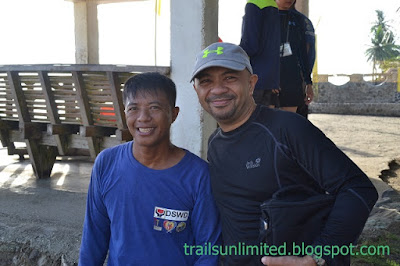I started my community development journey more than 15 years ago when I joined World Vision and was immersed in the realities of poor peoples’ lives in far flung areas all over the Philippines. As I engaged with them, I began to question the role of the government in helping the marginalized members of society rise up from their current conditions. It wasn’t hard to deduce why NGOs like World Vision thrive in this country because the social development arm of the government is not doing enough to alleviate poverty and needs other development groups to do the job for them.
 |
| If this is not transparent enough, then ask the people who benefited from this project... |
I guess then, judging was easy coming from somebody fresh out of the corporate world and just starting to learn about community development. Thankfully, when I got to work with Department of Social Welfare and Development (DSWD) teams during calamities and relief operations, my perception about the work they do in the grassroots level eventually changed. I realized that doing development on the government side has a different set of complexities and dynamics unseen by the public eye, which could be better understood given a chance.
 |
| This Health Center is serivicing three naighboring barangays in Dolores, Quezon |
Of course, I cannot also dismiss the fact that many shortcomings and limitations are the ones commonly highlighted by mainstream media. The truth is, there are also a lot of great things in this country we should be thankful about in terms of DSWD’s accomplishments in areas where government’s help is needed the most. Unfortunately, a lot of the milestones are often hidden in “reports” that are only circulated within the agency. If there is any news being sent out, appropriate packaging is often neglected thereby losing public receptiveness and, eventually, interest.
 |
| Fiberglass fishing boats made by fishermen themselves. Photo taken at Atimonan, Quezon |
Last week, I was invited by DSWD Region 4A to join a learning tour in communities they assist through programs such as the Kapit-bisig Laban sa Kahirapan – Comprehensive and Integrated Delivery of Social Services (KALAHI-CIDSS), Sustainable Livelihood Program (SLP), Modified Conditional Cash Transfer (MCCT), and the Pantawid Pamilyang Pilipino Program (4Ps), which has gained so much controversy and scrutiny coming from almost all sectors of the society.
 |
| With Kuya Ferdy, President of Fiberglass Fishing boats Association in Atimonan... |
My son, Gab and I, together with other bloggers as well as representatives of other NGOs and the academe got to visit the towns of Dolores, Candelaria, Lucena, Atimonan, and Gumaca to witness first-hand how these programs are being implemented and how they impact the lives of marginalized constituents. The community tour involved a series of lectures and stories not from development experts but by the beneficiaries themselves. These are mothers, farmers, fishermen, and Indigenous Peoples – the ones mostly affected greatly by calamities and insurgencies. Our visit to these areas highlighted how DSWD programs are continuously changing the lives of the poor for the better.
 |
| A Badjao Community in Lucena is learning Handicrafts using beads for potential livelihood... |
The tour was a personal encounter with the beneficiaries themselves. Each of us had the privilege to have one-on-one conversations with some of them and even for just a short while, we were able to learn a lot of valuable lessons on development and human transformation much better than any organizational development consultant can share. Even with my 15 years’ experience engaging with the grassroots communities, new interactions with them always generate life wisdom.
 |
| Farm-to-market road was constructed by the community themselves and is now servicing adjacent barangays... |
Our two-day stay in the provinces of Quezon was certainly not enough to capture everything in one blog post. I hope I can go back again and spend more time with them so I can learn more. Through their stories, I hope more Filipinos can appreciate how these poor people are striving and making the most out of the government resources being extended to them.
 |
| DSWD Region 4A Social Marketing Team with Bloggers and Social Media influencers... |
During the time of Martial Law in the seventies, the poverty rate in this country went up to almost 60 percent. Over time, this has gone down to 20 percent. Coinciding with this statistic, many of the non-government organizations giving assistance to the poor are slowly being phased out in many communities because the Philippines has been tagged as “lesser priority” in terms of development compared to other countries like those in Africa. These reports actually equate to the condition of a country that is slowly rising above poverty. And as much as we, as a people, have a long way to go, it is comforting to know that many of those in the poverty line refuse to accept that they are a burden to the society. Instead, they are contributing entities that this nation can likewise capitalize on.
No comments:
Post a Comment